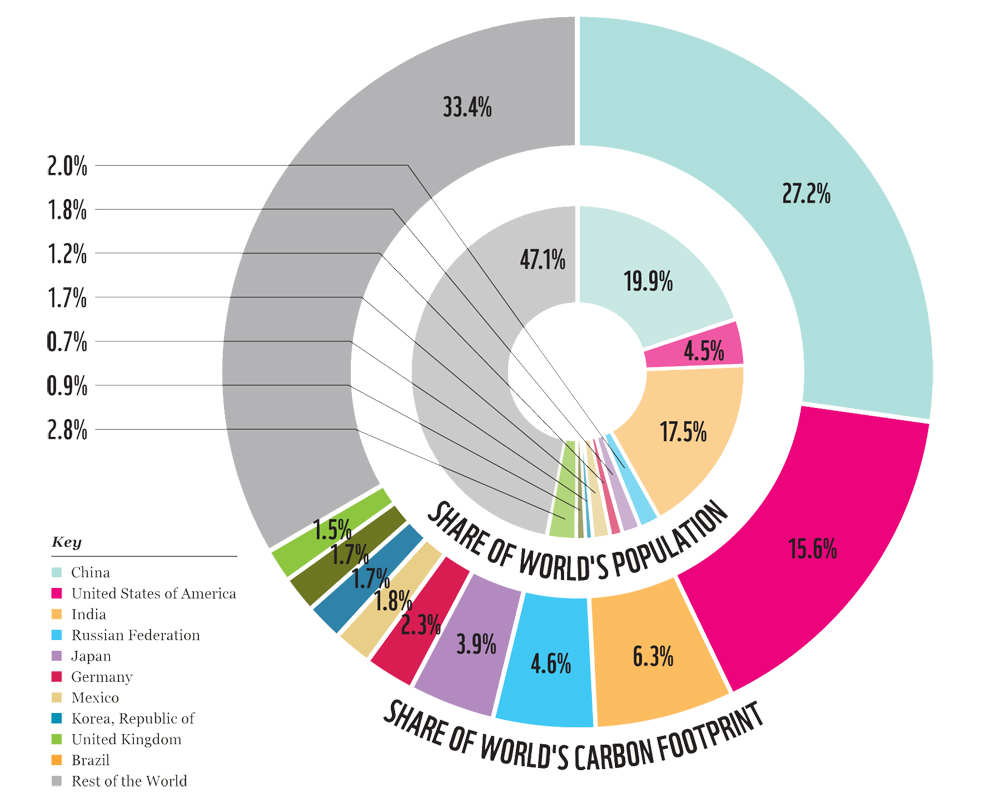The average carbon footprint for a person in the United States is 16 tons, one of the highest rates in the world. Globally, the average carbon footprint is closer to 4 tons. – nature.org
The Earth’s natural climate has constantly changed over time. But what happens when that change occurs much faster than in the past? For example, since the beginning of the Industrial Revolution, average temperatures worldwide have risen by around 1°C.
This increase can be attributed to humans burning fossil fuels such as coal, oil, and gas for fuel. These fuels release gases into the atmosphere that trap heat in their greenhouse effect. The world has been trying to fix this climate change since the 1980s by forming Intergovernmental Panel on Climate Change (IPCC)
As a plan to address this climate change, many initiatives are going on. For example, people involved in information technology are initiating a global movement called Green IT to incorporate technology into the sustainability equation, reducing its environmental footprint. In addition, many things to be done personally to thrive our environment to a carbon-neutral phase. It all starts with understanding our carbon footprint.
What is a carbon footprint?
A carbon footprint is the total amount of greenhouse gases released into the atmosphere by a person, organization, or country. These emissions can include carbon dioxide (CO2), methane (CH4), and nitrous oxide (N2O).
A personal carbon footprint is what you leave behind as a result of moving about, consuming, eating, and using resources like energy. For example, whenever you travel by car, charge your mobile phone, switch on the TV or run the washing machine, and do many other routine activities, you leave a trail of gases in your wake that builds up in the atmosphere and contributes to global warming. Carbon footprints are one way to measure how much we are contributing to this problem by our actions and habits.
Why is this important to know?
Understanding your carbon footprint is essential to reducing your impact on the environment and lowering your carbon footprint. This is because having a carbon footprint will allow you to understand how much of an environmental impact you are having on the planet and how you can reduce it. In addition, it helps you know where your energy comes from and where it goes. If you have a large one, chances are you have a lot of energy-intensive activities in your life—and if so, it’s time to consider what those activities mean for the environment.
As an individual, if we all took steps to reduce our carbon footprint, we could make a difference!

image by: veeterzy
How do I calculate my Carbon Footprint?
Calculating a carbon footprint is difficult because many factors affect how much energy, water, and other resources must be used to produce goods and services. For example, one might consider the personal cost of taking a commercial flight, considering the amount of fuel burned and greenhouse gas emissions emitted during the flight; however, many considerations can impact this calculation. For example, first-and-business-class passengers tend to use more space on an airplane than economy passengers, incentivizing airlines to fly them between their destinations. Other considerations include how much cargo the plane carries and how high it passes during its flight path. However, some tools and resources were invented to make the process easier.
The UN’s calculator is a great place to start. It considers aspects of the home — the type of housing, size, energy efficiency, etc. — and our usual mode of transport. It also feels our lifestyle, such as consuming meat and local products or managing food waste and technological waste. There are many more free tools available online to check your carbon footprint. Cabonfootprint.com provides one of the free tools.

Source: https://www.footprintnetwork.org
How can you reduce your carbon footprint?
Now that you’ve decided to reduce your carbon footprint, you can take some simple steps to ensure it happens.
First, make sure you choose fuel-efficient vehicles. Consider getting a hybrid or electric vehicle if you own a car or truck. If your business is located in an urban area, try walking, biking, or taking public transportation whenever possible.
Next, install efficient lighting fixtures in your home and workplace. This can help reduce energy consumption by up to 90 percent. It’s also good for your wallet—many LED lights use less than half the energy of incandescent bulbs and last up to 25 times longer!
Finally, consider eating less meat. Meat production accounts for nearly one-third of all human-related greenhouse gas emissions worldwide. By replacing red meat with beans and vegetables while still enjoying your favorite dishes, you can help save the planet while making delicious meals!

image by: Kelly Sikkema
We can summarize these actions according to European Union.
Food
- Consume local and seasonal products. (forget strawberries in winter)
- Limit meat consumption, especially beef.
- Select fish from sustainable fishing.
- Bring reusable shopping bags and avoid products with excessive plastic packaging.
- Make sure to buy what you only need to prevent waste.
Clothing
- Take good care of your clothes.
- Try swapping, borrowing, renting, or buying second-hand.
- Buy responsibly-made garments, e.g., made from recycled material or with an eco-label.
Transport
- Cycle or use public transport.
- Be smart about when and how you drive.
- Try the train for your next holiday.
Energy and waste
- Turn down the heating by 1°. It will already make a difference.
- Take short showers.
- Turn off the water while you brush your teeth or clean the dishes.
- Unplug your electronic equipment, and don’t leave your phone on charge when the battery is full.
- Don’t store unnecessary data in the cloud. (learn more about your digital footprint!)
- Select energy-efficient products with an “A” label. (EU Energy Label)
- Limit and recycle your waste.
Regarding computers and technology, start following simple actions suggested by BCS.org.
- Switching off computers, when not required, either by the users or automatically.
- Reduce the brightness on monitors.
Consume less with what you have
- Remove active screensavers – same power used to run a screen saver as in working.
- Reduce screen brightness and increase contrast.
- If monitors and printers have standby settings, use them.
- Where available, enable active power management on PCs and laptops.
- Apply timer switches to non-networked technology and printers.
- Share printers and other devices, e.g., comms, faxes, and servers.
- Share PCs and hot desk.
- Rethink data storage policies to reduce servers.
Take less from the environment
- Use recycled paper and recycled print cartridges and recycle again. Ask yourself – why print? If you have to.
- Set printers for double-sided or side-by-side printing as the default.
- Established printers for draft and grey printing.
- Adopt high-density fonts and maximize print areas.

image by: Ochir-Erdene Oyunmedeg
Although the concept of carbon footprint has not been around for a long time, we do have the power to make a difference by reducing our carbon footprint. Knowing personal Carbon footprint and taking steps to reduce it is something we can all do to help affect climate change. We should adopt this to our lifestyle by making it a habit.



0 Comments